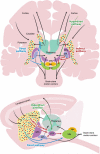Reassessing models of basal ganglia function and dysfunction
- PMID: 25032493
- PMCID: PMC4416475
- DOI: 10.1146/annurev-neuro-071013-013916
Reassessing models of basal ganglia function and dysfunction
Abstract
The basal ganglia are a series of interconnected subcortical nuclei. The function and dysfunction of these nuclei have been studied intensively in motor control, but more recently our knowledge of these functions has broadened to include prominent roles in cognition and affective control. This review summarizes historical models of basal ganglia function, as well as findings supporting or conflicting with these models, while emphasizing recent work in animals and humans directly testing the hypotheses generated by these models.
Keywords: Parkinson's disease; dopamine; striatum.
Figures

References
-
- Albin RL, Young AB, Penney JB. The functional anatomy of basal ganglia disorders. Trends in neurosciences. 1989;12:366–75. - PubMed
-
- Albin RL, Young AB, Penney JB, Handelin B, Balfour R, et al. Abnormalities of striatal projection neurons and N-methyl-D-aspartate receptors in presymptomatic Huntington's disease. The New England journal of medicine. 1990;322:1293–8. - PubMed
-
- Alexander GE, DeLong MR, Strick PL. Parallel organization of functionally segregated circuits linking basal ganglia and cortex. Annual review of neuroscience. 1986;9:357–81. - PubMed
-
- Aylward EH, Sparks BF, Field KM, Yallapragada V, Shpritz BD, et al. Onset and rate of striatal atrophy in preclinical Huntington disease. Neurology. 2004;63:66–72. - PubMed
Publication types
MeSH terms
Grants and funding
LinkOut - more resources
Full Text Sources
Other Literature Sources

